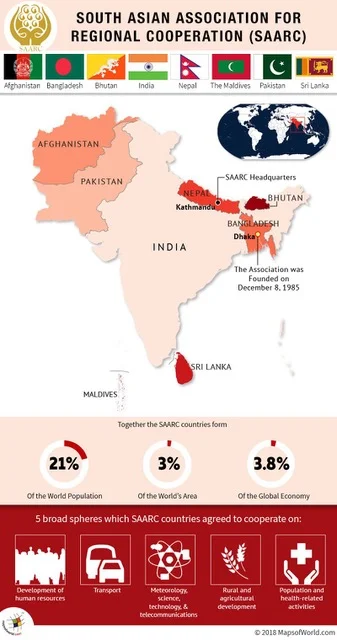UPSC Articles
INTERNATIONAL/ SECURITY
Topic: General Studies 2:
- Important International institutions, agencies and fora- their structure, mandate.
- Bilateral, regional and global groupings and agreements involving India and/or affecting India’s interests
Reclaiming SAARC from the ashes of 2020
Context: Thirty-six years after it first began, the South Asian Association for Regional Cooperation (SAARC), appears to be all but dead in the water.
- Suspended in action: The year 2020 marked the sixth year since the leaders of the eight nations that make up SAARC were able to meet.
- Impact of weakening SAARC: India-Pakistan issues have impacted other meetings of SAARC as well, making it easier for member countries, as well as international agencies to deal with South Asia as a fragmented group rather than a collective
- India’s Stand on not attending SAARC: PM Modi on the SAARC charter day on December 8, made it clear that India’s position on cross-border terrorism from Pakistan that led India to refuse to attend the SAARC summit in 2016 in Islamabad, is still in place.

Why India needs to rethink its position on SAARC?
- Pakistan’s undue influence: India’s problems with Pakistan on terrorism, territorial claims and on its role in blocking SAARC initiatives on connectivity and trade are well known. Even so, India’s refusal to allow Pakistan to host the SAARC summit because of those problems is akin to giving Pakistan a ‘veto’ over the entire SAARC process.
- Contradictory actions by India: PM Modi and cabinet ministers continued to attend Shanghai Cooperation Organisation (SCO) meetings along with their Pakistani counterparts, including the SCO Heads of Government meeting in November where New Delhi even invited Pakistan PM Imran Khan (he deputed another official).
- India’s dealing with other neighbours: While China’s incursions in Ladakh and the Galwan killings constituted the larger concern in the year, India did not decline to attend meetings with the Chinese leadership at the SCO, RIC trilateral, the G-20 and others. No concerns over territorial claims stopped the Indian government from engaging with Nepal either, despite Mr. K.P. Sharma Oli’s decision to change Nepal’s map and Constitution to include Indian territories.
- Pandemic induced challenges: Reviving SAARC is crucial to countering the common challenges brought about by the pandemic. South Asia’s unique experience with Pandemic, Vaccine distribution challenges, economic recovery especially tourism sector revival are some challenges that can be dealt effectively by close coordination by member countries
- Suitable time for regional approach: While it will be impossible for countries to cut themselves off from the global market entirely, regional initiatives will become the “Goldilocks option” (not too hot and not too cold), or the happy medium between globalisation and hyper-nationalism.
- Countermeasure to China: In dealing with the challenge from China too, both at India’s borders and in its neighbourhood, a unified South Asian platform remains India’s most potent countermeasure. Experts suggest that it is only a matter of time before Beijing holds a meeting of all SAARC countries (minus India and Bhutan), for they are all part of the BRI, and even that they will be invited to join RCEP, which India declined.
- Original logic of SAARC still holds true: Despite the despondency, the rationale for SAARC existence remains intact: while history and political grievances may be perceived differently, geography is reality.
Conclusion
New Delhi must find its own prism with which to view its South Asian neighbourhood as it should be: a unit that has a common future, and as a force-multiplier for India’s ambitions on the global stage.














